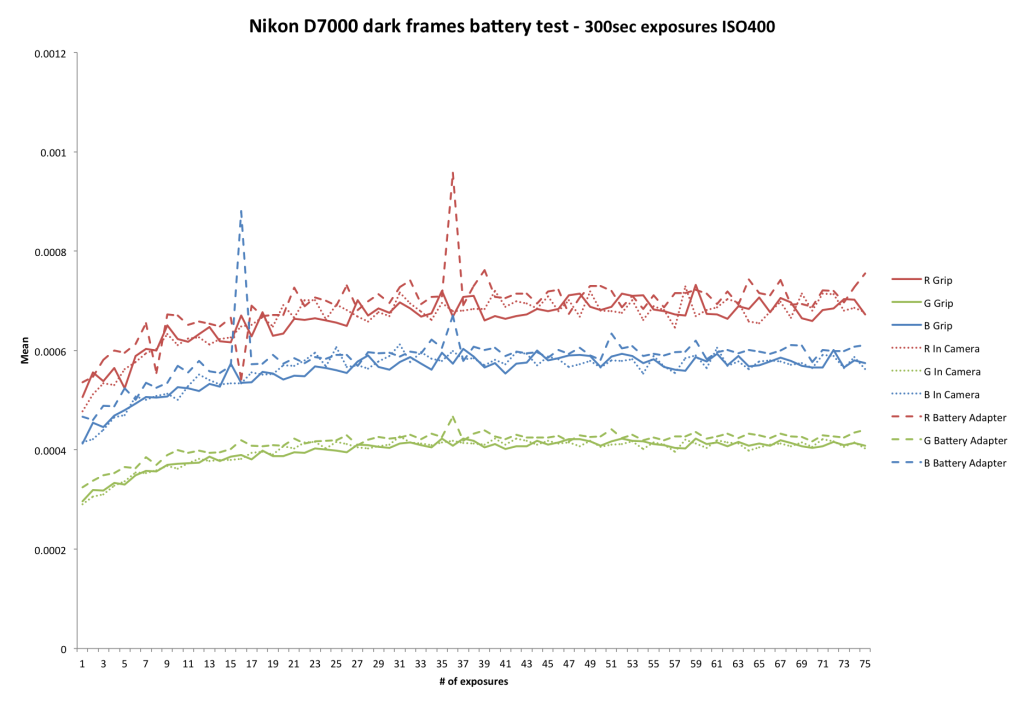One of the most significant noise sources is the thermal noise in camera. When we use long exposures, the sensor is heating up and generating noise. This made me wonder what role the battery inside the camera is playing in all of this as the battery will be warming up as well. So I figured it would be worthwhile to test out whether the battery is significant contributor to thermal noise or if it is neglectable.
Powering your DSLR without the in-camera battery
Basically there are two ways to power your camera without the battery that is residing inside the camera body; Use a battery grip and use a battery adapter and connect it to an external power source.
Since I want to avoid the need for in-session battery changes anyway, I bought a battery adapter with an external LiPo accu. This is a good way to get the power, and it’s associated warmth, really outside of the body. I already owned a battery grip so I decided to test if the battery is really something that is adding to the thermal noise.
Nikon D7000 battery thermal noise test
For this test I used the Nikon D7000 and shot dark frames at a constant ambient temperature at ISO400 and used 300sec. as exposure time. I shot 75 frames so you really have a view hours of continuous operating time for the camera and the battery.
I did three runs;
- Battery in body
- Battery in battery grip, (with NO battery in body!)
- External LiPo accu to power camera through a plastic dummy battery adapter
My hypothesis was that we would see a difference in thermal noise in the dark frames, where we would see the most noise in the first test and the least in the third test.
Now for the results:

If we look at the graph for the individual channels there seems to be not much of a difference. But the graph is not that clear, so leds just add up the mean values for each channel to get a total noise figure we can plot.

Hmmmmmm, not what I expected. Now we cannot help but notice that the adapter seemed to have more thermal noise than the other two. Also we see at least two clear spikes. What could be causing that?
Nikon D7000 thermal noise battery test – conclusion
The hypothesis that we can reduce noise by moving the battery outside of the body seems to be falsified by this test. We even see an increased noise level when using the battery adapter.
Of course this is just one test, and only for the Nikon D7000 but at least this gives an indication as to how likely it is you can reduce thermal noise by removing the battery.
There are other good reasons to use a battery adapter of course, so I’m still happy with that product. However, I must admit I’m a bit worried by the spikes in the graph. Need to find out what’s going on there. Lastly, I tested it with the original firmware of the D7000, which does all kinds of stuff with blackpoints so that you don’t really get a ‘true’ dark. I’ll repeat the test with the D5100 with a patched firmware version so we can compare true RAW darks.

A very thoughtful test. Batteries are usually a considered a low source of noise, but I havn’t seen numers for Lithium type. Some issues with adapters are possible signal connection to the mains ground which cann get noisy due to motors and lights switching on and off. Also the voltage conversion circuits can add a very low level of noise.
The batteries indeed are low noise voltage sources, and the LiPo are no exception. On the other side, the external power supply is probably a switchmode type, so it may well add noise to the system.
For my 450D i made a linear voltage reducer around an LM317. But never tought of comparing noise levels. For my new 60D I bought a commercial adapter. Time to test it 🙂
[…] You might try running a test of your equipment and seeing if you can see the 'heat' from the battery. This article suggests not. Does a battery in camera add to the thermal noise? | DSLR Astrophotography […]